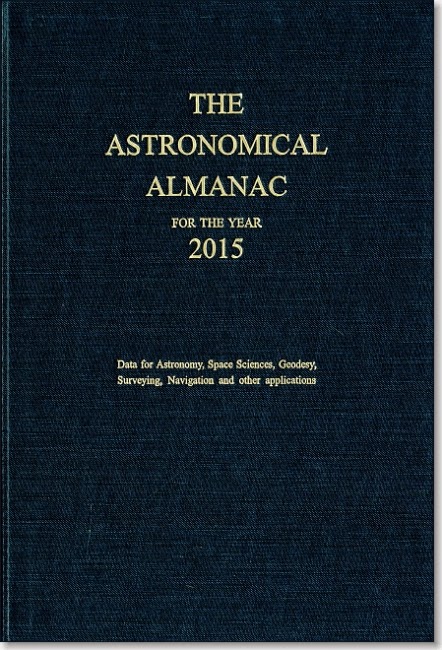The Astronomical Almanac contains a wide variety of both technical and general astronomical information. The book is a worldwide resource for fundamental astronomical data. It is a joint publication of the U.S. Nautical Almanac Office at the U.S. Naval Observatory and Her Majesty's Nautical Almanac Office in the UK, and contains data supplied by many scientists from around the world.
The material appears in sections, each section addressing a specific astronomical category. The book also includes references to the material, explanations, and examples. It is available one year in advance of its date.
Contents of The Astronomical Almanac:
- Section A: PHENOMENA
information on the seasons, phases of the Moon, configurations of the planets, eclipses, transits of Mercury or Venus, sunrise/set, moonrise/set times, and times for twilight. Preprints of many of these data appear in Astronomical Phenomena. - Section B: TIME-SCALES AND COORDINATE SYSTEMS
calendar information, relationships between time scales, universal and sidereal times, Earth rotation angle, definitions of the various celestial coordinate systems, frame bias, precession, nutation, obliquity, intermediate system, the position and velocity of the Earth, and coordinates of Polaris. Preprints of many of these data appear in Astronomical Phenomena. - Section C: SUN
detailed positional information on the Sun, including the ecliptic and equatorial coordinates, physical ephemerides, geocentric rectangular coordinates, times of transit, and the equation of time. - Section D: MOON
detailed positional information on the Moon including phases, mean elements of the orbit and rotation, lengths of mean months, ecliptic and equatorial coordinates, librations, and physical ephemerides. - Section E: PLANETS
detailed positional information on each of the major planets including osculating orbital elements, heliocentric ecliptic and geocentric equatorial coordinates, and physical ephemerides. - Section F: NATURAL SATELLITES
positional information on the satellites of Mars, Jupiter, Saturn (including the rings), Uranus, Neptune, and Pluto. - Section G: DWARF PLANETS AND SMALL SOLAR SYSTEM BODIES
positional and physical data on selected dwarf planets, positional information on bright minor planets and periodic comets. - Section H: STARS AND STELLAR SYSTEMS
mean places for bright stars, double stars, UBVRI standards, ubvy and H β standards, spectrophotometric standards, radial velocity standards, variable stars, exoplanet and host stars, bright galaxies, open clusters, globular clusters, ICRF2 radio source positions, radio flux calibrators, x-ray sources, quasars, pulsars, and gamma ray sources. - Section J: OBSERVATORIES
world wide index of observatory names, locations, MPC codes, and instrumentation in alphabetical order and by country. - Section K: TABLES AND DATA
Julian dates, selected astronomical constants, relations between time scales, coordinates of the celestial pole, reduction of terrestrial coordinates, interpolations methods, vectors and matrices. - Section L: NOTES AND REFERENCES
notes on the data and references for source material found in the volume. - Section M: GLOSSARY
terms and definitions for many of the words and phrases. - Section N: INDEX

